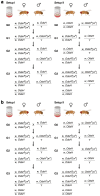Selection with two alleles of X-linkage and its application to the fitness component analysis of OdsH in Drosophila
- PMID: 39001870
- PMCID: PMC11537805
- DOI: 10.1093/g3journal/jkae157
Selection with two alleles of X-linkage and its application to the fitness component analysis of OdsH in Drosophila
Abstract
In organisms with the XY sex-determination system, there is an imbalance in the inheritance and transmission of the X chromosome between males and females. Unlike an autosomal allele, an X-linked recessive allele in a female will have phenotypic effects on its male counterpart. Thus, genes located on the X chromosome are of particular interest to researchers in molecular evolution and genetics. Here we present a model for selection with two alleles of X-linkage to understand fitness components associated with genes on the X chromosome. We apply this model to the fitness analysis of an X-linked gene, OdsH (16D), in the fruit fly Drosophila melanogaster. The function of OdsH is involved in sperm production and the gene is rapidly evolving under positive selection. Using site-directed gene targeting, we generated functional and defective OdsH variants tagged with the eye-color marker gene white. We compare the allele frequency changes of the two OdsH variants, each directly competing against a wild-type OdsH allele in concurrent but separate experimental populations. After 20 generations, the two genetically modified OdsH variants displayed a 40% difference in allele frequencies, with the functional OdsH variant demonstrating an advantage over the defective variant. Using maximum likelihood estimation, we determined the fitness components associated with the OdsH alleles in males and females. Our analysis revealed functional aspects of the fitness determinants associated with OdsH, and that sex-specific fertility and viability consequences both contribute to selection on an X-linked gene.
Keywords: OdsH; X-linkage; fitness components; selection; sex bias; two alleles.
© The Author(s) 2024. Published by Oxford University Press on behalf of The Genetics Society of America.
Conflict of interest statement
Conflicts of interest The authors declare no conflicts of interest.
Figures







Similar articles
-
Sex differences in deleterious mutational effects in Drosophila melanogaster: combining quantitative and population genetic insights.Genetics. 2021 Nov 5;219(3):iyab143. doi: 10.1093/genetics/iyab143. Genetics. 2021. PMID: 34740242 Free PMC article.
-
Maximum Likelihood Estimation of Fitness Components in Experimental Evolution.Genetics. 2019 Mar;211(3):1005-1017. doi: 10.1534/genetics.118.301893. Epub 2019 Jan 24. Genetics. 2019. PMID: 30679262 Free PMC article.
-
Reduction of germ cells in the Odysseus null mutant causes male fertility defect in Drosophila melanogaster.Genes Genet Syst. 2012;87(4):273-6. doi: 10.1266/ggs.87.273. Genes Genet Syst. 2012. PMID: 23229314
-
Fine mapping of dominant X-linked incompatibility alleles in Drosophila hybrids.PLoS Genet. 2014 Apr 17;10(4):e1004270. doi: 10.1371/journal.pgen.1004270. eCollection 2014 Apr. PLoS Genet. 2014. PMID: 24743238 Free PMC article.
-
A reanalysis of protein polymorphism in Drosophila melanogaster, D. simulans, D. sechellia and D. mauritiana: effects of population size and selection.Genetica. 2004 Mar;120(1-3):101-14. doi: 10.1023/b:gene.0000017634.17098.aa. Genetica. 2004. PMID: 15088651
References
-
- Barclay HJ, Fitz-Earle M. 1988. Maximum likelihood estimates of fitness in iteroparous species population replacement experiments using compound chromosomes. Genome. 30(1):83–88. doi:10.1139/g88-014 - DOI
-
- Beckenbach A. 1983. Fitness analysis of the “sex-ratio” polymorphism in experimental populations of Drosophila pseudoobscura. Am Nat. 121(5):630–648. doi:10.1086/284091 - DOI
MeSH terms
Substances
Grants and funding
LinkOut - more resources
Full Text Sources
Molecular Biology Databases
